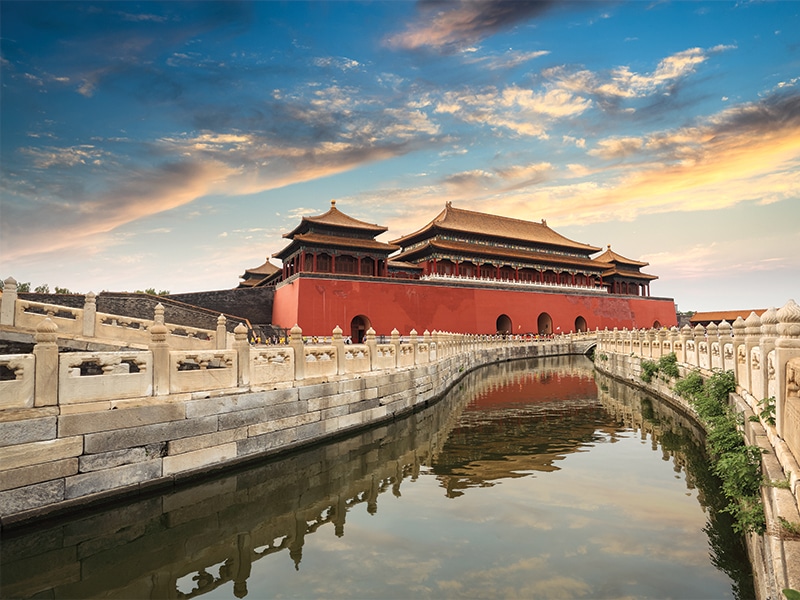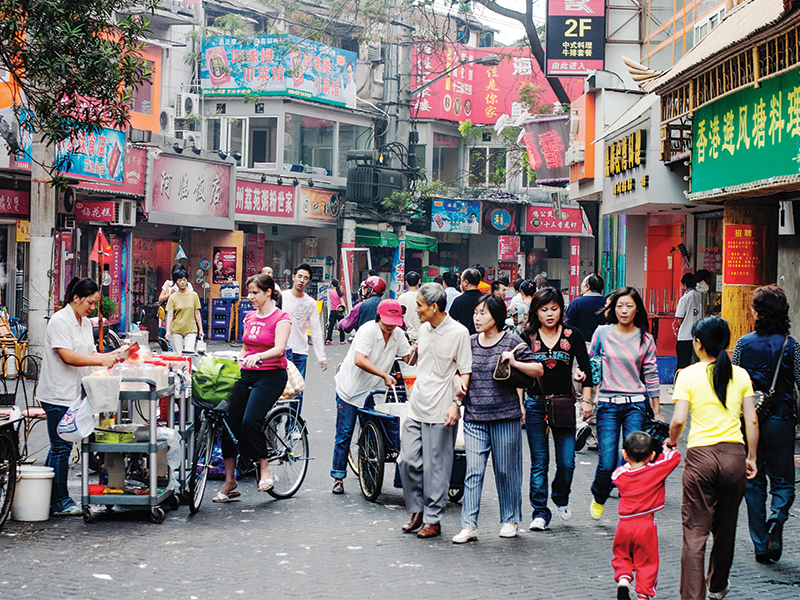From the Wall to the Warriors, China has something to offer every visitor. Here’s our guide to the Middle Kingdom’s two most famous cities, Beijing and Shanghai. Weigh up which one sounds right for your next trip!
Beijing – China’s capital

China’s capital is a sprawling mega-city of 22 million people. Oh, and five-and-a-half million cars! (Thankfully, an “odds and evens” number-plate system keeps traffic numbers down). This is a city of contrasts. Away from the wide boulevards lined with grand, statement buildings, which feel more akin to a European capital, are the narrow, grey hutongs, or traditional neighbourhoods.
Many of these historic warrens are within walking distance of two of Beijing’s best-known sights: the Forbidden City and Tiananmen Square. The central area that includes these landmarks is one of a handful that tourists should concentrate on. Others, a taxi ride away, include the shopping/nightlife enclave of Sanlitun and the art galleries of quirky 798 district. The renowned Summer Palace is anotherm must-see on any China trip.
Though many hutongs have sadly been demolished in the rush to modernisation, those that remain standing are protected. One is Wudaoying, close to the Forbidden City and home to the Drum Tower, once the city’s time-keeper. While many residents have sold and moved out to high-rise developments, there’s a certain feel to the hutongs that no apartment complex can replicate. Their narrow lanes, high walls and large, forbidding wooden doors conceal quaint courtyards shared by residents. Also shared, by tourists and residents alike, are the public toilets. (Warning: the low partitions do not allow much privacy.)

Eating dumplings for lunch and riding a rickshaw through the narrow alleys gives a fun glimpse of daily life. And stunning Lama Temple, Houhai Lake and Beihai Park are all easily accessible from Wudaoying. Furthermore, we highly recommend a boat ride across the lakes of Houhai or Beihai at sunset.
Forbidden City
In a half day, it’s possible to take in Tiananmen Square after a self-guided visit to the enormous 73-hectare Forbidden City. Grab an audio guide and prepared for walking, walking and more walking. The “city” itself is 750 metres from east to west, and 960 metres from north to south. There are reportedly 9,999 rooms! Every statisitc is amazing here. The moat is 52 metres wide and there are 308 copper pots that were used to hold water for fire-fighting.
As for the Square, it’s best to see it at sunset. That’s when soldiers lower the Chinese flag in a patriotic ceremony. Once you’ve finished in the Forbidden City, if it’s a clear day and you’ve still got some stamina, walk directly across the road from the northern exit to the lookout in Jingshan Park. The view over this part of Beijing is stunning. You’ll also understand, seeing the size of the Forbidden City, why your feet are throbbing.
The Great Wall
It’s a steep wall, and it’s steeped in myth and legend. (One myth we will debunk right now: the human eye cannot detect the Great Wall from space!) It’s also among the world’s biggest tourist attractions – and easily accessible from Beijing

Where to see the Great Wall
- Badaling – the most visited section of the Wall. Just 80 kilometres from Beijing, Badaling is completely renovated (for better or worse). It’s outfitted with wide paths and handrails, making it easier to climb than most sections. However, it’s also generally crammed with big tour operators.
- Mutianyu – less crowded than Badaling, though still popular with independent travellers and smaller tour groups. Cable cars shuttle tourists from the base to the top for spectacular views. To get down, hike, jump on a cable car or opt for a wind-in-your-hair toboggan ride.
- Simatai – the two-hour drive from Beijing deters most tourists, as do the plunging cliffs, jagged ridges and super-steep watch towers. The charm of this section is that it’s largely unrenovated, though major parts are now closed exactly for this reason.
- Huanghuacheng and Jiankou – strictly for those with hiking boots and a healthy relationship with heights! The stretches are steeper and the bricks looser along these unrestored parts of the wall.
- Other parts – a group called Beijing Hikers organises tours to more remote parts of the wall. This is a decent option for strong-backed tourists who loathe weak-backed ones!

Shanghai – a showcase of modern China

Many families travelling with children bypass Shanghai in favour of Beijing, because it has fewer landmark tourist sights. But this cosmopolitan city of 23 million has much to entertain young minds. Given that Singapore already offers children great waterparks and zoos, there’s not much point spending time at similar attractions when there are some of the world’s tallest buildings and unique neighbourhoods to explore.
Though the landmark 468-metre Oriental Pearl Tower in Pudong is no longer the city’s tallest building (it was overtaken by the Shanghai World Financial Centre in 2008, and then in 2016 by the Shanghai Tower, the world’s second tallest building at 632 metres), it does house the impressive Shanghai History Museum. Through models, dioramas and special effects, it lays out the story of the city from its beginnings as a village 1,000 years ago to global prominence in the 1930s, along with its present-day obsession with skyscrapers.
The Bund & Yu Garden
Across the Huangpu River (crisscrossed by 10 tunnels and 10 bridges), visit the 1.5km riverfront promenade known as the Bund. Whether you walk, drive or take a boat cruise to see its 20 or more century-old buildings, it’s handy to have a guide or a brochure with information about each building.
The labyrinthine Yu Garden is one of the city’s biggest attractions. Separated into small courtyards by dragon-shaped walls, the gardens were built in 1559 in traditional style and overflow with wooden pavilions, koi ponds, pagodas, stunning trees and a 12-metre-high rockery. Outside you’ll find a beautiful wooden bridge and a crowded shopping bazaar. Despite being overrun with tourists, it’s worth braving. From here, escape into the narrow alleys of the Old Town and the markets on Yuyuan Street.

French Concession & Xintiandi
The European concessions are designated areas of the city that were granted to foreign countries in Shanghai the 1800s. Shanghai operated as a treaty port, which meant that foreign countries had their own jurisdictions; the respective neighbourhoods subsequently developed strong cultural identities. Taking a self-guided walking tour around the tree-lined back streets feels, at times, like strolling through a European city.
Many people head for Xintiandi, where upmarket boutiques and restaurants have gentrified the traditional 19thcentury shikumen houses. (Shikumen is a traditional Shanghainese architectural style marked by grey-and-red-brick walls and arches.) Ironically, this lavish commercial area was also the location of the First Congress of the Chinese Communist Party.
In China’s rush to modernity, traditional handicrafts have thankfully not been forsaken. At the Museum of Arts and Crafts, visitors can watch dozens of artisans at work, including jade- and wood-carvers, paper-cutters, embroiderers, jewellers and painters. Housed in a stately 100-year-old French mansion with sweeping staircases, it’s a place to find authentic souvenirs; the artisans will intrigue curious children, too.

Markets & shops
Amongst the myriad shopping and tailoring options, it’s hard to beat the AP Markets. It’s located in the basement of the Shanghai Science and Technology Museum. Directly accessible by the Metro station named after the museum, the markets are the place to bargain hard for knock-off goods including clothes, shoes and leather handbags. Take a suitcase, or buy one, to take home your China purchases.
Finally, see Shanghai’s – and China’s – restless energy on display in the warren of laneways known as Tian Zi Fang. This bohemian mix of studios, cafés and quirky shops spreads across narrow alleys teeming with atmosphere. Whether you’re shopping or not, it’s a unique neighbourhood to get lost in.
Day trips from Shanghai
Hangzhou
Hangzhou is the home of China’s famed West Lake. This domestic tourist magnet is an area of natural beauty (when the smog cooperates, of course). Catch misty scenes of tai chi being performed on the water’s edge at sunrise, drink a cup of longjing tea made with leaves plucked in nearby plantations, tour the many temples and monasteries that dot the area, and book a seat at Impression West Lake, a spectacular outdoor performance directed by Zhang Yimou, the mastermind behind the 2008 Beijing Summer Olympics opening and closing ceremonies.

Zhujiajiao
On the edge of Shanghai’s urban sprawl, a dozen or so ancient villages line the small lakes and waterways of the Yangzi River delta. Zhujiajiao is a pleasant enough half-day trip, though be aware that anything authentic has long disappeared, and most of the quaint town shops now sell food and souvenirs. Still, the old Ming- and Qing-dynasty architecture, including bridges across the narrow canals, is atmospheric, and many visitors take a leisurely boat ride.

Suzhou
Trace the steps of artists, scholars and the high society of China through gardens, canals and arched bridges in this busy but picturesque town. Express trains can get you from Shanghai to Suzhou in less than 30 minutes. Highlights include the West Garden Temple, the Taoist Temple of Mystery, and an hour-long boat ride around the outer canal every evening starting from the Renmin Bridge.
This article first appeared in Expat Living’s Travel Guide. You can purchase a copy or subscribe so you never miss an issue!





